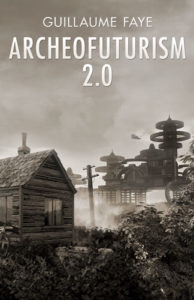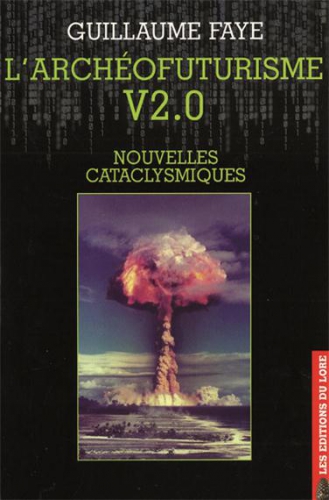 Review:
Review:
Guillaume Faye
Archeofuturism 2.0 [2]
Arktos Media, 2016
Renowned Right-wing author Guillaume Faye has written his first novel, Archeofuturism 2.0. So you might ask: is it a good one? Has he delivered? Is this something for Faye fans, maybe even science fiction fans, to buy?
We’d answer “yes” to all these questions. Previously, Faye has been persuasive as a stylish writer in books like Archeofuturism [3] and Why We Fight [4]; he has a way with words, he has made an impression, and now, in this novel, he takes the reader for a prophetically grim but linguistically smooth ride. He tells his story with efficiency and charm, and he has managed to make a novel of it. It might be episodic, and the chapters might be called “episodes” (not “chapters”) to emphasise this, but with a certain symbolic flair he connects all the chapters. Hats off; this puts it on par with, say, Clifford D. Simak’s City [5](1952). It’s a future history with a broad gallery of scenes, intrigues, and developments. Millennia pass, but it all comes together rather well at the end.
The first chapter in particular is top notch: efficient, displaying narrative ease and charm, and with a lot of concepts and opinions in the mix. A group of young aristocrats is planning to go to the Riviera in the summer of 1914 – and, before heading south, they go on a whim to consult a soothsayer in a Paris suburb. She then gives the group visions of the future, successively three, fifteen, twenty-five, and a hundred years hence. The fine men and women are aghast at hearing of war and disaster, mass immigration, and the fall of civilization. Then the group goes south, and their festive spirit is soon destroyed by rumors of war, and then by actual war. Austria-Hungary attacks Serbia, and soon all of Europe is at war.
Faye takes us through the war in quick and yet enticing scenes, and then just as effectively portrays development up until the mid-twenty-first century, which is when the fall of the West happens. And that’s merely what’s contained in the first episode. Then, things continue into a dismal future, where things get “archaic” coupled with some “futurism,” and voilà, archeofuturism: a future cleansed with archaic perspectives, just as in the original book. Civilization breaks down, but then science regroups and comes to the fore again; not that it leads to any shiny, technotronic paradise. Rather, it is a field day for the titanic pessimist. This reviewer didn’t quite enjoy this part of the book, or virtually the rest of it as regards the conceptual side of it or the ideas peddled, but as such, Faye is faithful to his views and this is his suggestion for a future scenario.
 The book’s vision of a non-spiritual, titanic, and only partially scientifically developed (and also part degenerate) future leads you into a not-so-uncommon “feel bad” territory, as is not unknown in contemporary science fiction. Dystopia, the fall of civilization, doom and gloom. So what is there to say about it all? We’d say: Faye is a debutant of fiction. (Okay, the first Archeofuturism book indeed had an appendix that was a kind of short story, so already there the author had signaled the viability of fiction for his purposes.) Nevertheless, he tells his well-crafted story with confidence and wit, so we shouldn’t complain too much. We’d even like to read more Faye fiction, perhaps stories set in twentieth-century France or some such theme, given the allure of the setting of the first episode in this book.
The book’s vision of a non-spiritual, titanic, and only partially scientifically developed (and also part degenerate) future leads you into a not-so-uncommon “feel bad” territory, as is not unknown in contemporary science fiction. Dystopia, the fall of civilization, doom and gloom. So what is there to say about it all? We’d say: Faye is a debutant of fiction. (Okay, the first Archeofuturism book indeed had an appendix that was a kind of short story, so already there the author had signaled the viability of fiction for his purposes.) Nevertheless, he tells his well-crafted story with confidence and wit, so we shouldn’t complain too much. We’d even like to read more Faye fiction, perhaps stories set in twentieth-century France or some such theme, given the allure of the setting of the first episode in this book.
In Archeofuturism 2.0 we get a Right-wing, radical conservative view of our times and beyond, and it’s fine as such. There aren’t that many such novels written today. It develops into a pessimistic tale of science as the lodestar. Natural science and technology become the focus of man’s striving – not spirituality and not esotericism. Let’s just say that we’d prefer a future with a modicum of mindfulness to keep us eminently awake.
The novel is convincing – as science fiction. Faye adds an epilogue – and there, he’s stating his creed in no uncertain terms – evolution rules, stick to the program, and forget everything else. And science predicts that someday, our planet will almost certainly be hit by a near-Earth Object. And after that, the cockroaches will rule . . . ?
Faye doesn’t say the latter. Instead, he delivers his payoff as a kind of afterthought, a line intimating a reasonable approach: “What do you think?” This indeed has the character of afterthought, and it would sit fine in an essay – but, when writing fiction, you have to obey its unwritten rules. A writer of fiction shapes his reality, he enacts the world he has in mind, and therefore he mustn’t throw in caveats and footnotes. There are indeed some lengthy notes to the tenth episode, showing that the author has done his homework in terms of space technology and so on, but they too are out of place in a fictional setting.
Essentially, writing fiction is myth-making. It’s revelation. It has to aim at mythic poignancy. In fiction, you can’t take the easy way out that is permitted in an essay, where the format allows you to discuss this and that.
The fiction author should be ruthless. “The spirit of song is war,” as Edith Södergran said. You have to artistically stand by your creation and not support it with extra-artistic means.
That said, and going back to the novel at hand, let’s remember what we said above, namely that it’s convincing. In most respects – its narrative skill, the conceiving of its science, history, sociology, and so on in a fictional setting, and as a radical conservative statement in novelistic form – Archeofuturism 2.0 is more than satisfactory. From an artistic point of view, we don’t mind that the novel is a bit weird and strange in its visions of the future – no, not at all, since the vision is mostly conveyed with skill. As well as charm, that has got to be underlined; the reader is swept along, and he generally has a good time. Overall, it’s a rather excellent effort.
Above, we mentioned Simak’s City as a similar science fiction opus, similar in that it is a chronicle of the future in separate yet connected episodes. In terms of its general atmosphere, Archeofuturism 2.0 can also make you think of the graphic novel Blake and Mortimer [6], Belgian E. P. Jacobs’ stories which often had a science fictional setting, such as The Time Trap [7] (1962), a story with a rather elaborate-but-dismal future. (And for the record, in one chapter of his novel, Faye has a character named “Grossgrabenstein,” a name that also appears in Jacobs’ The Mystery of the Great Pyramid [8] from 1954.) You might even mention Jules Verne, who (in his later works) had this “belief in science, yet also pessimistic” mindset that Faye displays.
We get the urge to equate Faye’s narrative skills with those of the graphic novel writer Pierre Christin, the creator of Valérian [9]. In this opus, Christin has made the Laureline character rather memorable, and in equal measure Faye has a way with his female characters. They are rather prominent in this future history. Discreetly, they carry a lot of the action without the gender-related fuss they are embellished with in Left-leaning novels.





 del.icio.us
del.icio.us
 Digg
Digg


 La guerre actuelle en Europe s'est imposée à nous sans nous demander notre avis. Elle remonte au début de 2015 avec les attentats contre Charlie Hebdo et contre l'Hyper Casher. Elle s'est poursuivie en France, en Belgique, en Allemagne. C'est une guerre qui n'est pas une guerre classique.
La guerre actuelle en Europe s'est imposée à nous sans nous demander notre avis. Elle remonte au début de 2015 avec les attentats contre Charlie Hebdo et contre l'Hyper Casher. Elle s'est poursuivie en France, en Belgique, en Allemagne. C'est une guerre qui n'est pas une guerre classique.